University Employment Relations Analysis Report: HRM3014, Semester 2
VerifiedAdded on 2023/04/25
|18
|5515
|364
Report
AI Summary
This report analyzes various aspects of employment relations. It begins by exploring the factors that deter employers from making reasonable adjustments for disabled workers, examining whether these factors stem from genuine barriers or social constructs. The report then compares and contrasts the equal opportunities and diversity management approaches, evaluating whether they are necessarily opposing ideas. Next, it assesses the relevance of the flexible firm model in contemporary organizations. The report also explains the attraction-selection-attrition (ASA) framework and critically evaluates its role in explaining why organizations struggle to recruit and retain a diverse workforce. Finally, the report addresses role congruity theory in explaining women's under-representation in leadership and discusses methods to reduce resistance to diversity within organizations.
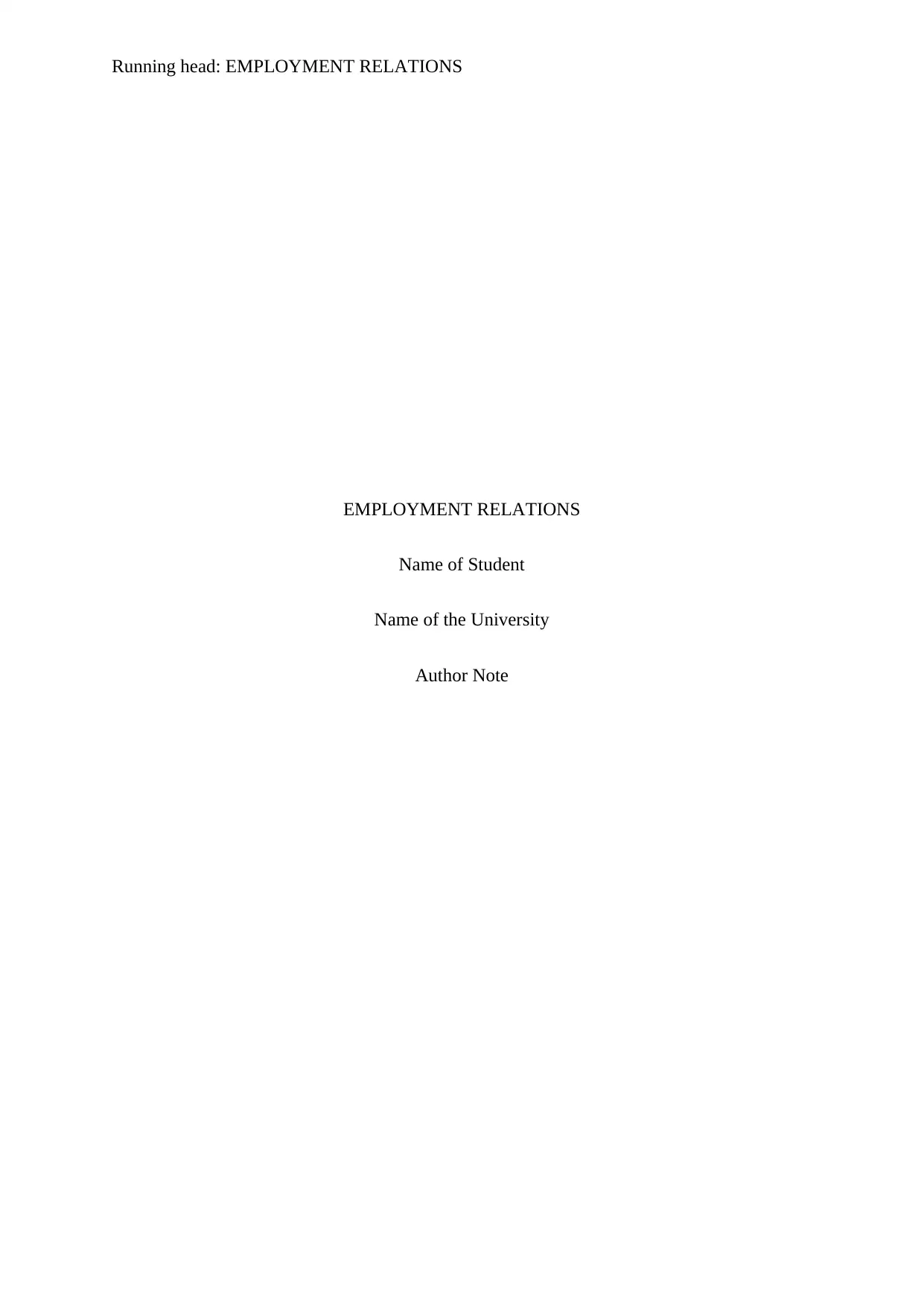
Running head: EMPLOYMENT RELATIONS
EMPLOYMENT RELATIONS
Name of Student
Name of the University
Author Note
EMPLOYMENT RELATIONS
Name of Student
Name of the University
Author Note
Paraphrase This Document
Need a fresh take? Get an instant paraphrase of this document with our AI Paraphraser
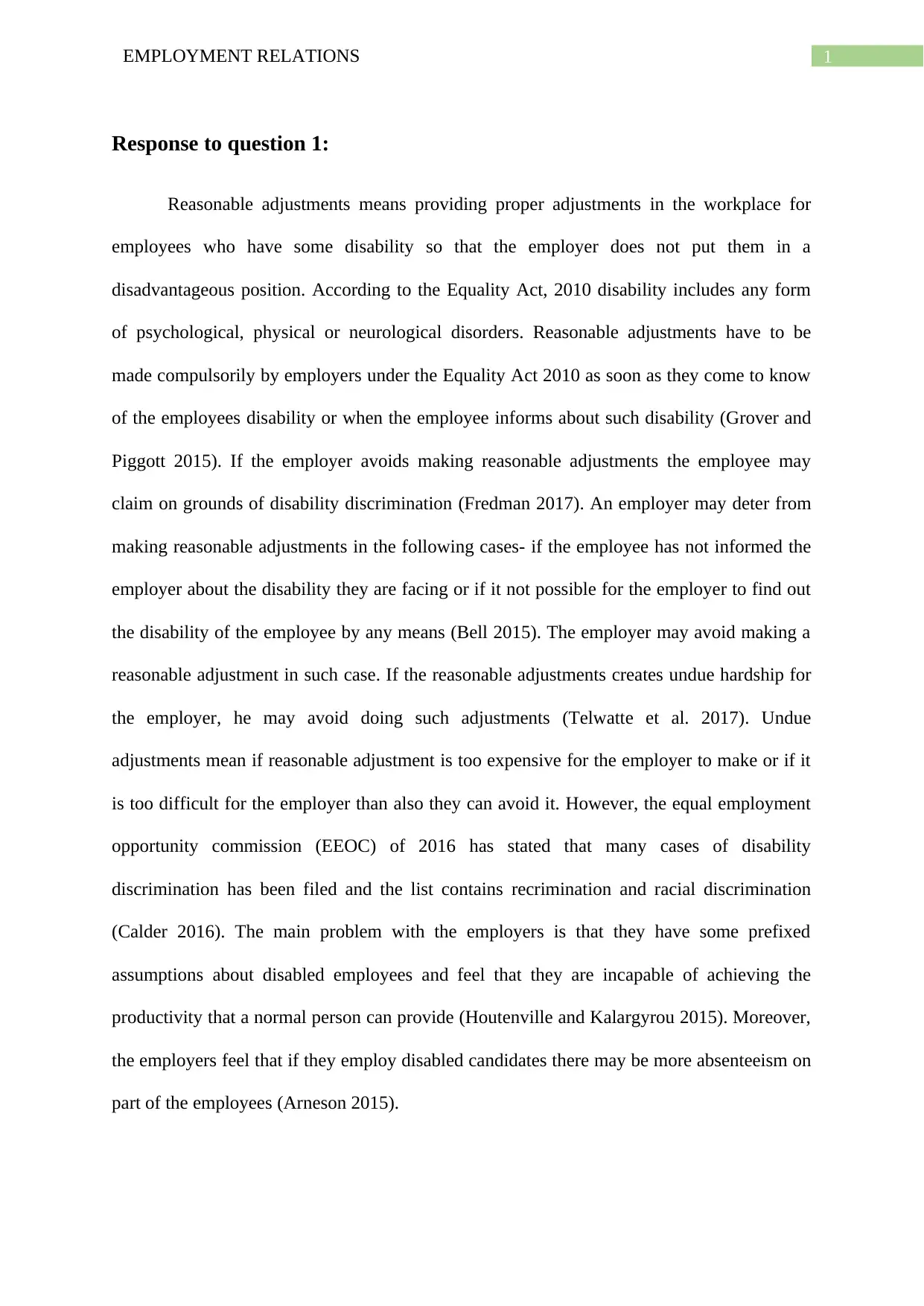
1EMPLOYMENT RELATIONS
Response to question 1:
Reasonable adjustments means providing proper adjustments in the workplace for
employees who have some disability so that the employer does not put them in a
disadvantageous position. According to the Equality Act, 2010 disability includes any form
of psychological, physical or neurological disorders. Reasonable adjustments have to be
made compulsorily by employers under the Equality Act 2010 as soon as they come to know
of the employees disability or when the employee informs about such disability (Grover and
Piggott 2015). If the employer avoids making reasonable adjustments the employee may
claim on grounds of disability discrimination (Fredman 2017). An employer may deter from
making reasonable adjustments in the following cases- if the employee has not informed the
employer about the disability they are facing or if it not possible for the employer to find out
the disability of the employee by any means (Bell 2015). The employer may avoid making a
reasonable adjustment in such case. If the reasonable adjustments creates undue hardship for
the employer, he may avoid doing such adjustments (Telwatte et al. 2017). Undue
adjustments mean if reasonable adjustment is too expensive for the employer to make or if it
is too difficult for the employer than also they can avoid it. However, the equal employment
opportunity commission (EEOC) of 2016 has stated that many cases of disability
discrimination has been filed and the list contains recrimination and racial discrimination
(Calder 2016). The main problem with the employers is that they have some prefixed
assumptions about disabled employees and feel that they are incapable of achieving the
productivity that a normal person can provide (Houtenville and Kalargyrou 2015). Moreover,
the employers feel that if they employ disabled candidates there may be more absenteeism on
part of the employees (Arneson 2015).
Response to question 1:
Reasonable adjustments means providing proper adjustments in the workplace for
employees who have some disability so that the employer does not put them in a
disadvantageous position. According to the Equality Act, 2010 disability includes any form
of psychological, physical or neurological disorders. Reasonable adjustments have to be
made compulsorily by employers under the Equality Act 2010 as soon as they come to know
of the employees disability or when the employee informs about such disability (Grover and
Piggott 2015). If the employer avoids making reasonable adjustments the employee may
claim on grounds of disability discrimination (Fredman 2017). An employer may deter from
making reasonable adjustments in the following cases- if the employee has not informed the
employer about the disability they are facing or if it not possible for the employer to find out
the disability of the employee by any means (Bell 2015). The employer may avoid making a
reasonable adjustment in such case. If the reasonable adjustments creates undue hardship for
the employer, he may avoid doing such adjustments (Telwatte et al. 2017). Undue
adjustments mean if reasonable adjustment is too expensive for the employer to make or if it
is too difficult for the employer than also they can avoid it. However, the equal employment
opportunity commission (EEOC) of 2016 has stated that many cases of disability
discrimination has been filed and the list contains recrimination and racial discrimination
(Calder 2016). The main problem with the employers is that they have some prefixed
assumptions about disabled employees and feel that they are incapable of achieving the
productivity that a normal person can provide (Houtenville and Kalargyrou 2015). Moreover,
the employers feel that if they employ disabled candidates there may be more absenteeism on
part of the employees (Arneson 2015).
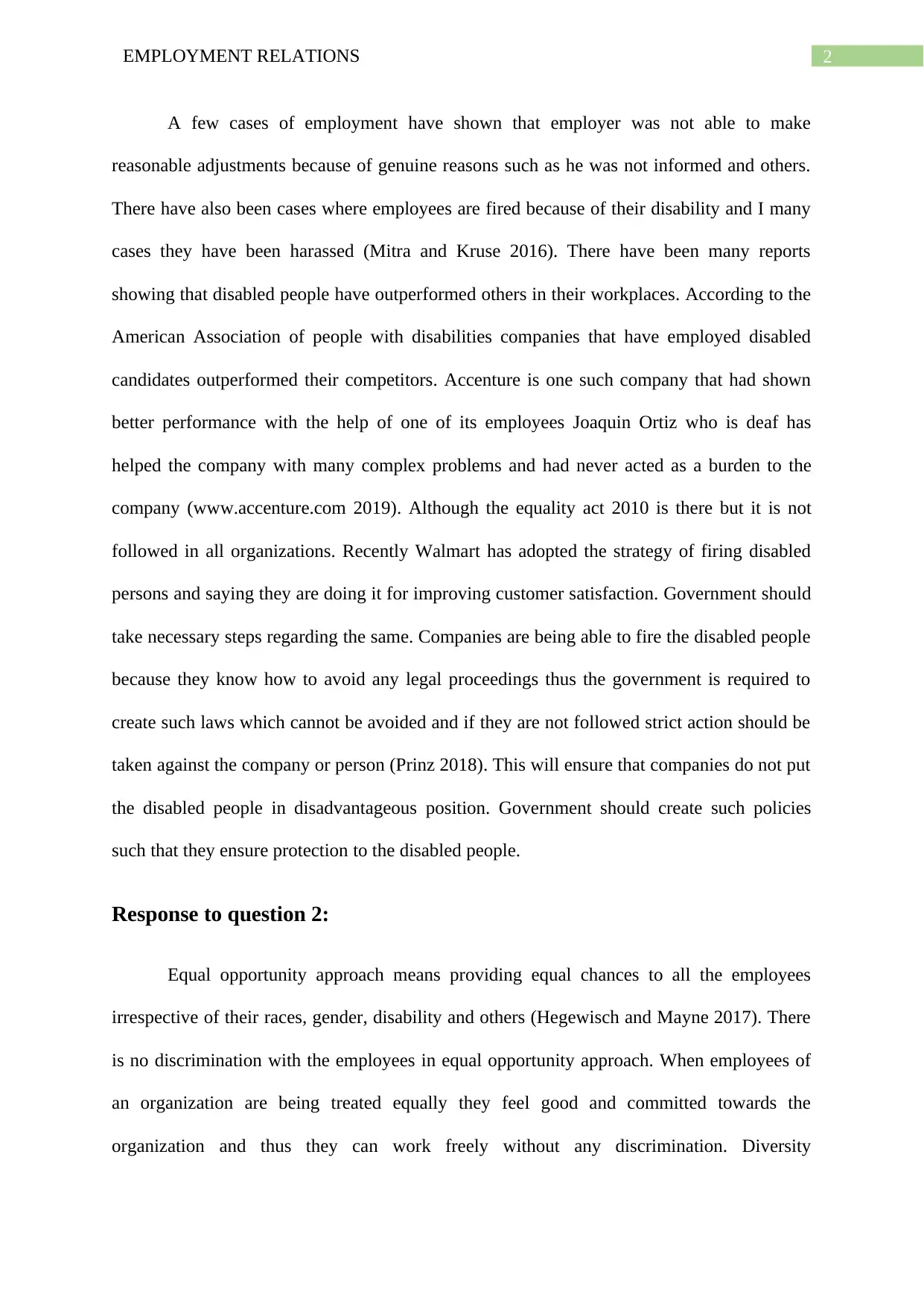
2EMPLOYMENT RELATIONS
A few cases of employment have shown that employer was not able to make
reasonable adjustments because of genuine reasons such as he was not informed and others.
There have also been cases where employees are fired because of their disability and I many
cases they have been harassed (Mitra and Kruse 2016). There have been many reports
showing that disabled people have outperformed others in their workplaces. According to the
American Association of people with disabilities companies that have employed disabled
candidates outperformed their competitors. Accenture is one such company that had shown
better performance with the help of one of its employees Joaquin Ortiz who is deaf has
helped the company with many complex problems and had never acted as a burden to the
company (www.accenture.com 2019). Although the equality act 2010 is there but it is not
followed in all organizations. Recently Walmart has adopted the strategy of firing disabled
persons and saying they are doing it for improving customer satisfaction. Government should
take necessary steps regarding the same. Companies are being able to fire the disabled people
because they know how to avoid any legal proceedings thus the government is required to
create such laws which cannot be avoided and if they are not followed strict action should be
taken against the company or person (Prinz 2018). This will ensure that companies do not put
the disabled people in disadvantageous position. Government should create such policies
such that they ensure protection to the disabled people.
Response to question 2:
Equal opportunity approach means providing equal chances to all the employees
irrespective of their races, gender, disability and others (Hegewisch and Mayne 2017). There
is no discrimination with the employees in equal opportunity approach. When employees of
an organization are being treated equally they feel good and committed towards the
organization and thus they can work freely without any discrimination. Diversity
A few cases of employment have shown that employer was not able to make
reasonable adjustments because of genuine reasons such as he was not informed and others.
There have also been cases where employees are fired because of their disability and I many
cases they have been harassed (Mitra and Kruse 2016). There have been many reports
showing that disabled people have outperformed others in their workplaces. According to the
American Association of people with disabilities companies that have employed disabled
candidates outperformed their competitors. Accenture is one such company that had shown
better performance with the help of one of its employees Joaquin Ortiz who is deaf has
helped the company with many complex problems and had never acted as a burden to the
company (www.accenture.com 2019). Although the equality act 2010 is there but it is not
followed in all organizations. Recently Walmart has adopted the strategy of firing disabled
persons and saying they are doing it for improving customer satisfaction. Government should
take necessary steps regarding the same. Companies are being able to fire the disabled people
because they know how to avoid any legal proceedings thus the government is required to
create such laws which cannot be avoided and if they are not followed strict action should be
taken against the company or person (Prinz 2018). This will ensure that companies do not put
the disabled people in disadvantageous position. Government should create such policies
such that they ensure protection to the disabled people.
Response to question 2:
Equal opportunity approach means providing equal chances to all the employees
irrespective of their races, gender, disability and others (Hegewisch and Mayne 2017). There
is no discrimination with the employees in equal opportunity approach. When employees of
an organization are being treated equally they feel good and committed towards the
organization and thus they can work freely without any discrimination. Diversity
⊘ This is a preview!⊘
Do you want full access?
Subscribe today to unlock all pages.

Trusted by 1+ million students worldwide
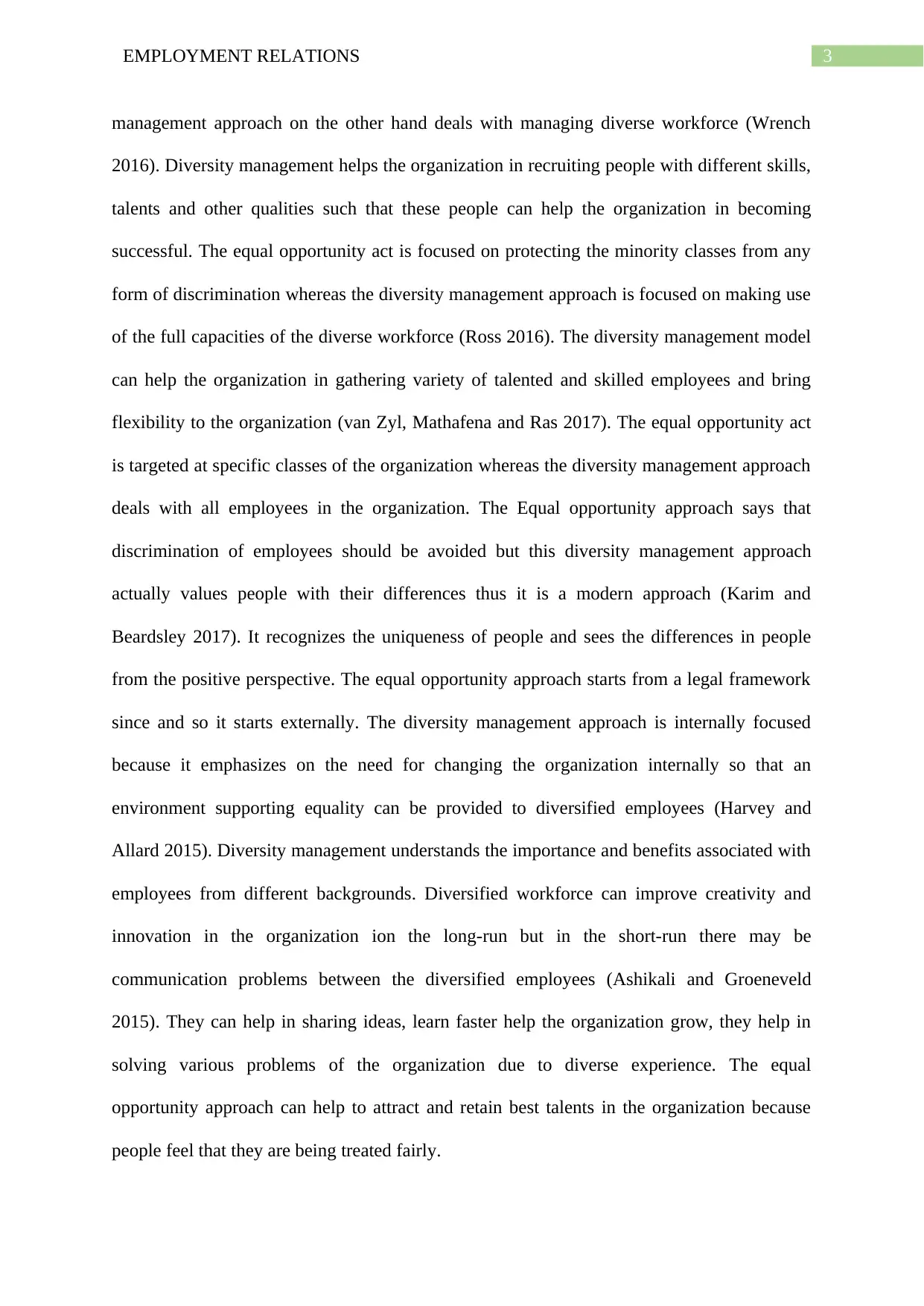
3EMPLOYMENT RELATIONS
management approach on the other hand deals with managing diverse workforce (Wrench
2016). Diversity management helps the organization in recruiting people with different skills,
talents and other qualities such that these people can help the organization in becoming
successful. The equal opportunity act is focused on protecting the minority classes from any
form of discrimination whereas the diversity management approach is focused on making use
of the full capacities of the diverse workforce (Ross 2016). The diversity management model
can help the organization in gathering variety of talented and skilled employees and bring
flexibility to the organization (van Zyl, Mathafena and Ras 2017). The equal opportunity act
is targeted at specific classes of the organization whereas the diversity management approach
deals with all employees in the organization. The Equal opportunity approach says that
discrimination of employees should be avoided but this diversity management approach
actually values people with their differences thus it is a modern approach (Karim and
Beardsley 2017). It recognizes the uniqueness of people and sees the differences in people
from the positive perspective. The equal opportunity approach starts from a legal framework
since and so it starts externally. The diversity management approach is internally focused
because it emphasizes on the need for changing the organization internally so that an
environment supporting equality can be provided to diversified employees (Harvey and
Allard 2015). Diversity management understands the importance and benefits associated with
employees from different backgrounds. Diversified workforce can improve creativity and
innovation in the organization ion the long-run but in the short-run there may be
communication problems between the diversified employees (Ashikali and Groeneveld
2015). They can help in sharing ideas, learn faster help the organization grow, they help in
solving various problems of the organization due to diverse experience. The equal
opportunity approach can help to attract and retain best talents in the organization because
people feel that they are being treated fairly.
management approach on the other hand deals with managing diverse workforce (Wrench
2016). Diversity management helps the organization in recruiting people with different skills,
talents and other qualities such that these people can help the organization in becoming
successful. The equal opportunity act is focused on protecting the minority classes from any
form of discrimination whereas the diversity management approach is focused on making use
of the full capacities of the diverse workforce (Ross 2016). The diversity management model
can help the organization in gathering variety of talented and skilled employees and bring
flexibility to the organization (van Zyl, Mathafena and Ras 2017). The equal opportunity act
is targeted at specific classes of the organization whereas the diversity management approach
deals with all employees in the organization. The Equal opportunity approach says that
discrimination of employees should be avoided but this diversity management approach
actually values people with their differences thus it is a modern approach (Karim and
Beardsley 2017). It recognizes the uniqueness of people and sees the differences in people
from the positive perspective. The equal opportunity approach starts from a legal framework
since and so it starts externally. The diversity management approach is internally focused
because it emphasizes on the need for changing the organization internally so that an
environment supporting equality can be provided to diversified employees (Harvey and
Allard 2015). Diversity management understands the importance and benefits associated with
employees from different backgrounds. Diversified workforce can improve creativity and
innovation in the organization ion the long-run but in the short-run there may be
communication problems between the diversified employees (Ashikali and Groeneveld
2015). They can help in sharing ideas, learn faster help the organization grow, they help in
solving various problems of the organization due to diverse experience. The equal
opportunity approach can help to attract and retain best talents in the organization because
people feel that they are being treated fairly.
Paraphrase This Document
Need a fresh take? Get an instant paraphrase of this document with our AI Paraphraser
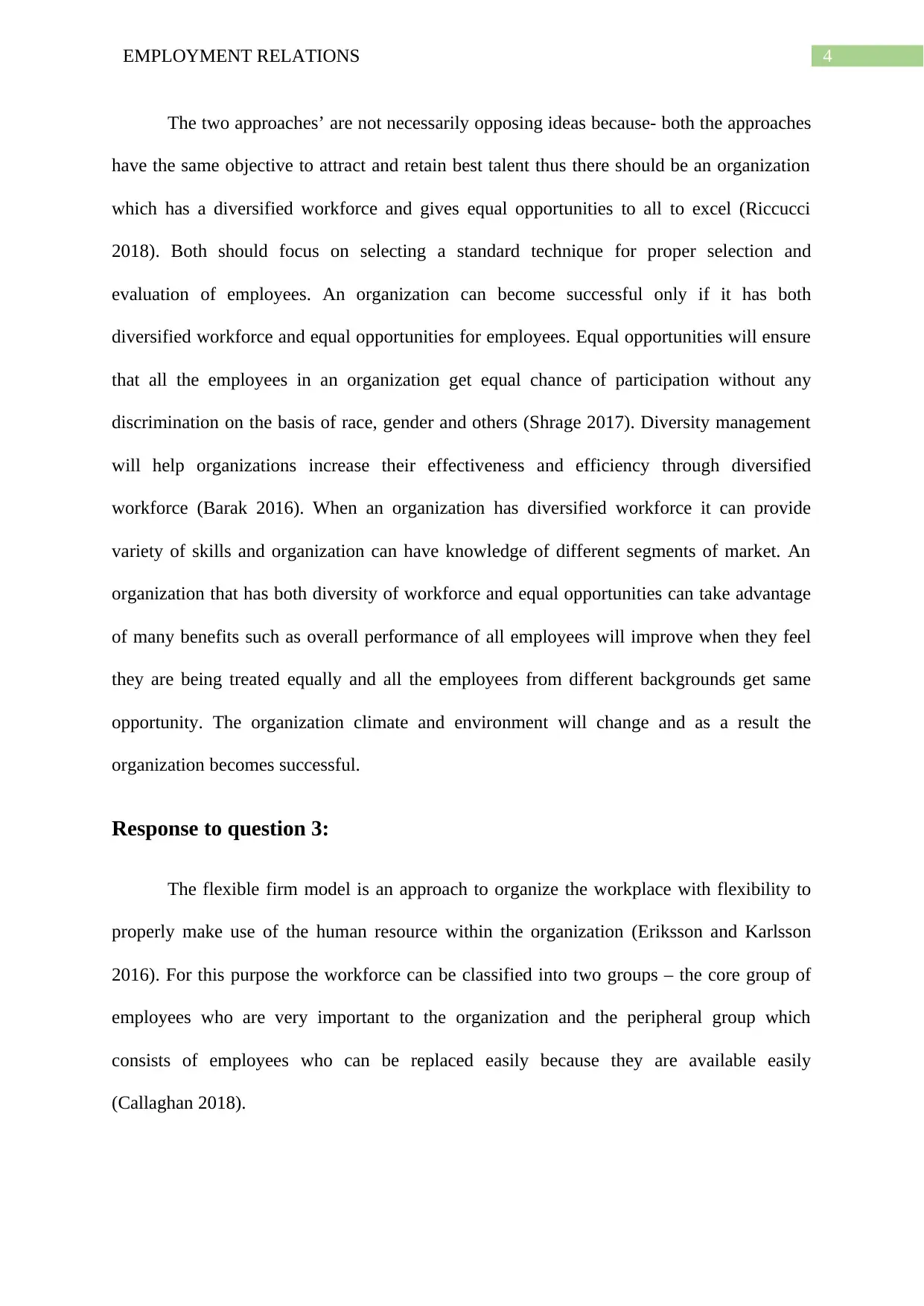
4EMPLOYMENT RELATIONS
The two approaches’ are not necessarily opposing ideas because- both the approaches
have the same objective to attract and retain best talent thus there should be an organization
which has a diversified workforce and gives equal opportunities to all to excel (Riccucci
2018). Both should focus on selecting a standard technique for proper selection and
evaluation of employees. An organization can become successful only if it has both
diversified workforce and equal opportunities for employees. Equal opportunities will ensure
that all the employees in an organization get equal chance of participation without any
discrimination on the basis of race, gender and others (Shrage 2017). Diversity management
will help organizations increase their effectiveness and efficiency through diversified
workforce (Barak 2016). When an organization has diversified workforce it can provide
variety of skills and organization can have knowledge of different segments of market. An
organization that has both diversity of workforce and equal opportunities can take advantage
of many benefits such as overall performance of all employees will improve when they feel
they are being treated equally and all the employees from different backgrounds get same
opportunity. The organization climate and environment will change and as a result the
organization becomes successful.
Response to question 3:
The flexible firm model is an approach to organize the workplace with flexibility to
properly make use of the human resource within the organization (Eriksson and Karlsson
2016). For this purpose the workforce can be classified into two groups – the core group of
employees who are very important to the organization and the peripheral group which
consists of employees who can be replaced easily because they are available easily
(Callaghan 2018).
The two approaches’ are not necessarily opposing ideas because- both the approaches
have the same objective to attract and retain best talent thus there should be an organization
which has a diversified workforce and gives equal opportunities to all to excel (Riccucci
2018). Both should focus on selecting a standard technique for proper selection and
evaluation of employees. An organization can become successful only if it has both
diversified workforce and equal opportunities for employees. Equal opportunities will ensure
that all the employees in an organization get equal chance of participation without any
discrimination on the basis of race, gender and others (Shrage 2017). Diversity management
will help organizations increase their effectiveness and efficiency through diversified
workforce (Barak 2016). When an organization has diversified workforce it can provide
variety of skills and organization can have knowledge of different segments of market. An
organization that has both diversity of workforce and equal opportunities can take advantage
of many benefits such as overall performance of all employees will improve when they feel
they are being treated equally and all the employees from different backgrounds get same
opportunity. The organization climate and environment will change and as a result the
organization becomes successful.
Response to question 3:
The flexible firm model is an approach to organize the workplace with flexibility to
properly make use of the human resource within the organization (Eriksson and Karlsson
2016). For this purpose the workforce can be classified into two groups – the core group of
employees who are very important to the organization and the peripheral group which
consists of employees who can be replaced easily because they are available easily
(Callaghan 2018).
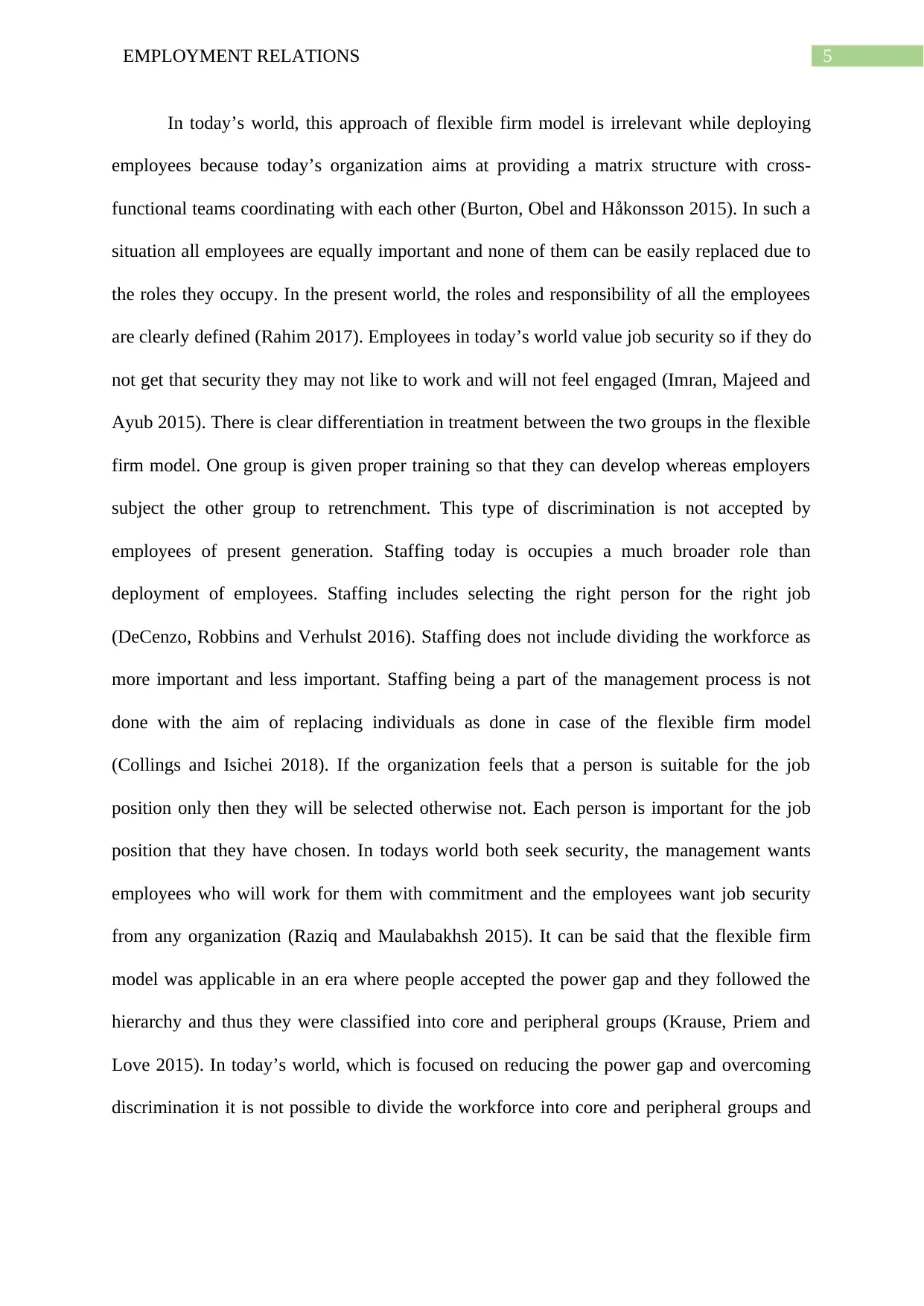
5EMPLOYMENT RELATIONS
In today’s world, this approach of flexible firm model is irrelevant while deploying
employees because today’s organization aims at providing a matrix structure with cross-
functional teams coordinating with each other (Burton, Obel and Håkonsson 2015). In such a
situation all employees are equally important and none of them can be easily replaced due to
the roles they occupy. In the present world, the roles and responsibility of all the employees
are clearly defined (Rahim 2017). Employees in today’s world value job security so if they do
not get that security they may not like to work and will not feel engaged (Imran, Majeed and
Ayub 2015). There is clear differentiation in treatment between the two groups in the flexible
firm model. One group is given proper training so that they can develop whereas employers
subject the other group to retrenchment. This type of discrimination is not accepted by
employees of present generation. Staffing today is occupies a much broader role than
deployment of employees. Staffing includes selecting the right person for the right job
(DeCenzo, Robbins and Verhulst 2016). Staffing does not include dividing the workforce as
more important and less important. Staffing being a part of the management process is not
done with the aim of replacing individuals as done in case of the flexible firm model
(Collings and Isichei 2018). If the organization feels that a person is suitable for the job
position only then they will be selected otherwise not. Each person is important for the job
position that they have chosen. In todays world both seek security, the management wants
employees who will work for them with commitment and the employees want job security
from any organization (Raziq and Maulabakhsh 2015). It can be said that the flexible firm
model was applicable in an era where people accepted the power gap and they followed the
hierarchy and thus they were classified into core and peripheral groups (Krause, Priem and
Love 2015). In today’s world, which is focused on reducing the power gap and overcoming
discrimination it is not possible to divide the workforce into core and peripheral groups and
In today’s world, this approach of flexible firm model is irrelevant while deploying
employees because today’s organization aims at providing a matrix structure with cross-
functional teams coordinating with each other (Burton, Obel and Håkonsson 2015). In such a
situation all employees are equally important and none of them can be easily replaced due to
the roles they occupy. In the present world, the roles and responsibility of all the employees
are clearly defined (Rahim 2017). Employees in today’s world value job security so if they do
not get that security they may not like to work and will not feel engaged (Imran, Majeed and
Ayub 2015). There is clear differentiation in treatment between the two groups in the flexible
firm model. One group is given proper training so that they can develop whereas employers
subject the other group to retrenchment. This type of discrimination is not accepted by
employees of present generation. Staffing today is occupies a much broader role than
deployment of employees. Staffing includes selecting the right person for the right job
(DeCenzo, Robbins and Verhulst 2016). Staffing does not include dividing the workforce as
more important and less important. Staffing being a part of the management process is not
done with the aim of replacing individuals as done in case of the flexible firm model
(Collings and Isichei 2018). If the organization feels that a person is suitable for the job
position only then they will be selected otherwise not. Each person is important for the job
position that they have chosen. In todays world both seek security, the management wants
employees who will work for them with commitment and the employees want job security
from any organization (Raziq and Maulabakhsh 2015). It can be said that the flexible firm
model was applicable in an era where people accepted the power gap and they followed the
hierarchy and thus they were classified into core and peripheral groups (Krause, Priem and
Love 2015). In today’s world, which is focused on reducing the power gap and overcoming
discrimination it is not possible to divide the workforce into core and peripheral groups and
⊘ This is a preview!⊘
Do you want full access?
Subscribe today to unlock all pages.

Trusted by 1+ million students worldwide
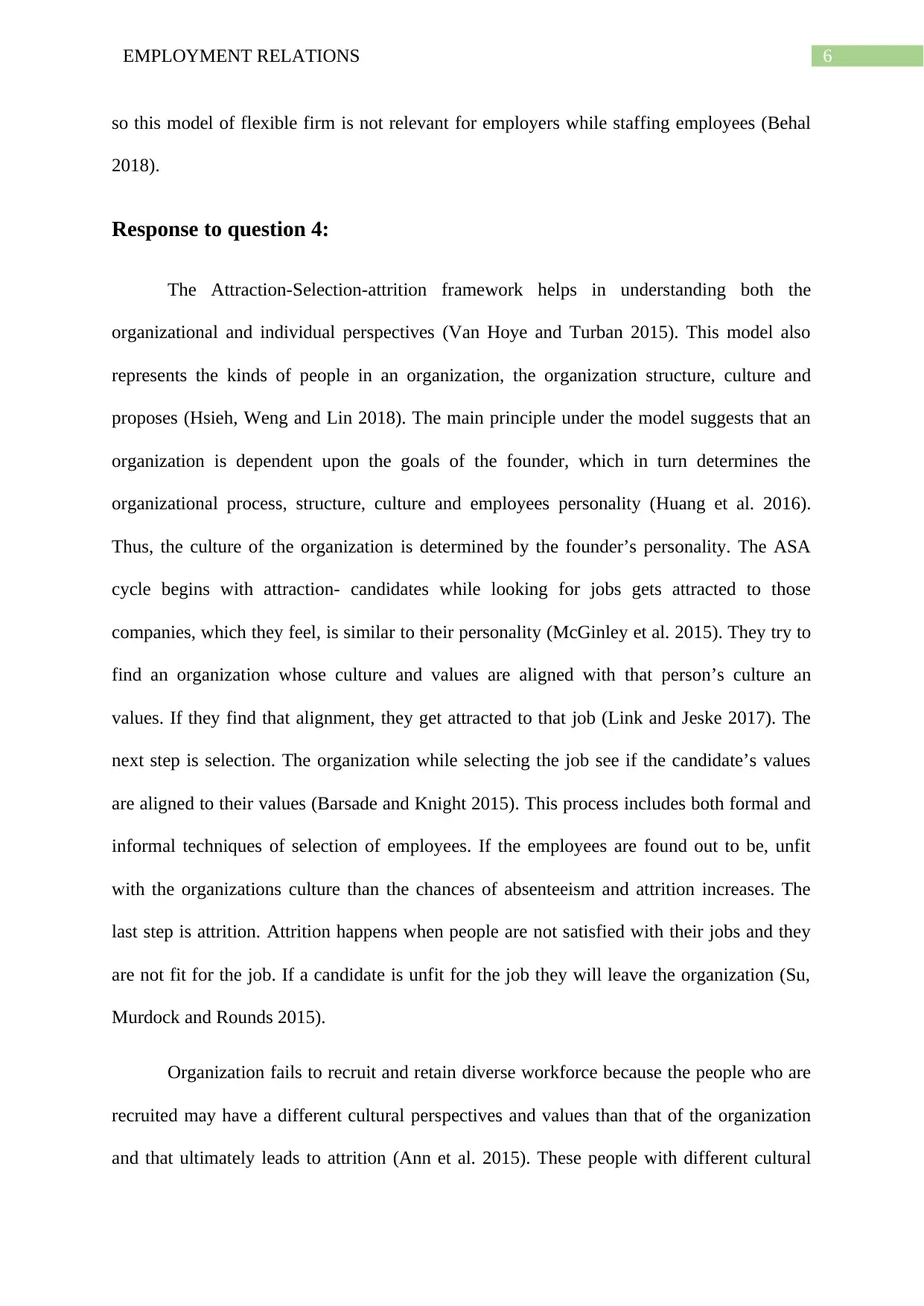
6EMPLOYMENT RELATIONS
so this model of flexible firm is not relevant for employers while staffing employees (Behal
2018).
Response to question 4:
The Attraction-Selection-attrition framework helps in understanding both the
organizational and individual perspectives (Van Hoye and Turban 2015). This model also
represents the kinds of people in an organization, the organization structure, culture and
proposes (Hsieh, Weng and Lin 2018). The main principle under the model suggests that an
organization is dependent upon the goals of the founder, which in turn determines the
organizational process, structure, culture and employees personality (Huang et al. 2016).
Thus, the culture of the organization is determined by the founder’s personality. The ASA
cycle begins with attraction- candidates while looking for jobs gets attracted to those
companies, which they feel, is similar to their personality (McGinley et al. 2015). They try to
find an organization whose culture and values are aligned with that person’s culture an
values. If they find that alignment, they get attracted to that job (Link and Jeske 2017). The
next step is selection. The organization while selecting the job see if the candidate’s values
are aligned to their values (Barsade and Knight 2015). This process includes both formal and
informal techniques of selection of employees. If the employees are found out to be, unfit
with the organizations culture than the chances of absenteeism and attrition increases. The
last step is attrition. Attrition happens when people are not satisfied with their jobs and they
are not fit for the job. If a candidate is unfit for the job they will leave the organization (Su,
Murdock and Rounds 2015).
Organization fails to recruit and retain diverse workforce because the people who are
recruited may have a different cultural perspectives and values than that of the organization
and that ultimately leads to attrition (Ann et al. 2015). These people with different cultural
so this model of flexible firm is not relevant for employers while staffing employees (Behal
2018).
Response to question 4:
The Attraction-Selection-attrition framework helps in understanding both the
organizational and individual perspectives (Van Hoye and Turban 2015). This model also
represents the kinds of people in an organization, the organization structure, culture and
proposes (Hsieh, Weng and Lin 2018). The main principle under the model suggests that an
organization is dependent upon the goals of the founder, which in turn determines the
organizational process, structure, culture and employees personality (Huang et al. 2016).
Thus, the culture of the organization is determined by the founder’s personality. The ASA
cycle begins with attraction- candidates while looking for jobs gets attracted to those
companies, which they feel, is similar to their personality (McGinley et al. 2015). They try to
find an organization whose culture and values are aligned with that person’s culture an
values. If they find that alignment, they get attracted to that job (Link and Jeske 2017). The
next step is selection. The organization while selecting the job see if the candidate’s values
are aligned to their values (Barsade and Knight 2015). This process includes both formal and
informal techniques of selection of employees. If the employees are found out to be, unfit
with the organizations culture than the chances of absenteeism and attrition increases. The
last step is attrition. Attrition happens when people are not satisfied with their jobs and they
are not fit for the job. If a candidate is unfit for the job they will leave the organization (Su,
Murdock and Rounds 2015).
Organization fails to recruit and retain diverse workforce because the people who are
recruited may have a different cultural perspectives and values than that of the organization
and that ultimately leads to attrition (Ann et al. 2015). These people with different cultural
Paraphrase This Document
Need a fresh take? Get an instant paraphrase of this document with our AI Paraphraser
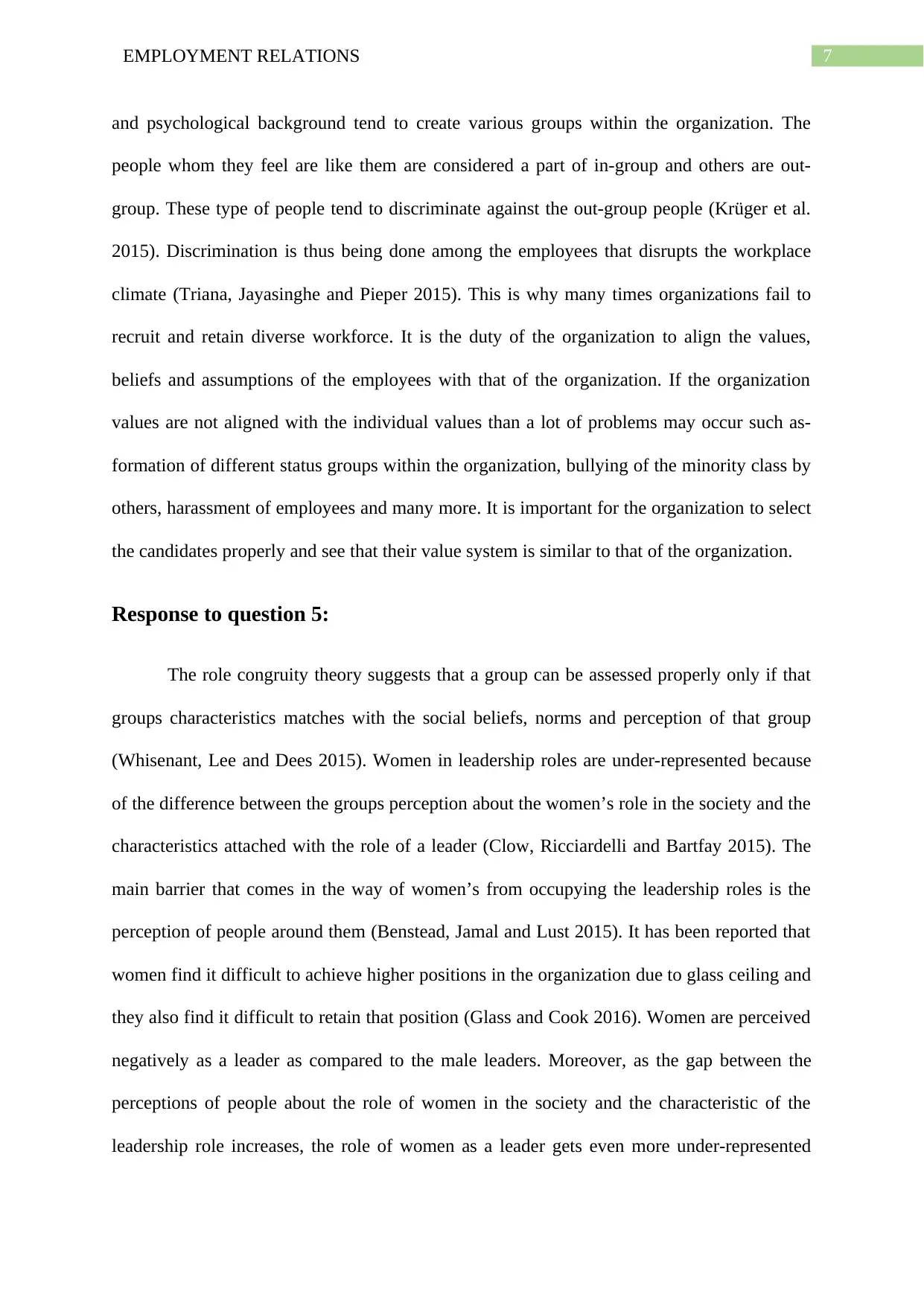
7EMPLOYMENT RELATIONS
and psychological background tend to create various groups within the organization. The
people whom they feel are like them are considered a part of in-group and others are out-
group. These type of people tend to discriminate against the out-group people (Krüger et al.
2015). Discrimination is thus being done among the employees that disrupts the workplace
climate (Triana, Jayasinghe and Pieper 2015). This is why many times organizations fail to
recruit and retain diverse workforce. It is the duty of the organization to align the values,
beliefs and assumptions of the employees with that of the organization. If the organization
values are not aligned with the individual values than a lot of problems may occur such as-
formation of different status groups within the organization, bullying of the minority class by
others, harassment of employees and many more. It is important for the organization to select
the candidates properly and see that their value system is similar to that of the organization.
Response to question 5:
The role congruity theory suggests that a group can be assessed properly only if that
groups characteristics matches with the social beliefs, norms and perception of that group
(Whisenant, Lee and Dees 2015). Women in leadership roles are under-represented because
of the difference between the groups perception about the women’s role in the society and the
characteristics attached with the role of a leader (Clow, Ricciardelli and Bartfay 2015). The
main barrier that comes in the way of women’s from occupying the leadership roles is the
perception of people around them (Benstead, Jamal and Lust 2015). It has been reported that
women find it difficult to achieve higher positions in the organization due to glass ceiling and
they also find it difficult to retain that position (Glass and Cook 2016). Women are perceived
negatively as a leader as compared to the male leaders. Moreover, as the gap between the
perceptions of people about the role of women in the society and the characteristic of the
leadership role increases, the role of women as a leader gets even more under-represented
and psychological background tend to create various groups within the organization. The
people whom they feel are like them are considered a part of in-group and others are out-
group. These type of people tend to discriminate against the out-group people (Krüger et al.
2015). Discrimination is thus being done among the employees that disrupts the workplace
climate (Triana, Jayasinghe and Pieper 2015). This is why many times organizations fail to
recruit and retain diverse workforce. It is the duty of the organization to align the values,
beliefs and assumptions of the employees with that of the organization. If the organization
values are not aligned with the individual values than a lot of problems may occur such as-
formation of different status groups within the organization, bullying of the minority class by
others, harassment of employees and many more. It is important for the organization to select
the candidates properly and see that their value system is similar to that of the organization.
Response to question 5:
The role congruity theory suggests that a group can be assessed properly only if that
groups characteristics matches with the social beliefs, norms and perception of that group
(Whisenant, Lee and Dees 2015). Women in leadership roles are under-represented because
of the difference between the groups perception about the women’s role in the society and the
characteristics attached with the role of a leader (Clow, Ricciardelli and Bartfay 2015). The
main barrier that comes in the way of women’s from occupying the leadership roles is the
perception of people around them (Benstead, Jamal and Lust 2015). It has been reported that
women find it difficult to achieve higher positions in the organization due to glass ceiling and
they also find it difficult to retain that position (Glass and Cook 2016). Women are perceived
negatively as a leader as compared to the male leaders. Moreover, as the gap between the
perceptions of people about the role of women in the society and the characteristic of the
leadership role increases, the role of women as a leader gets even more under-represented
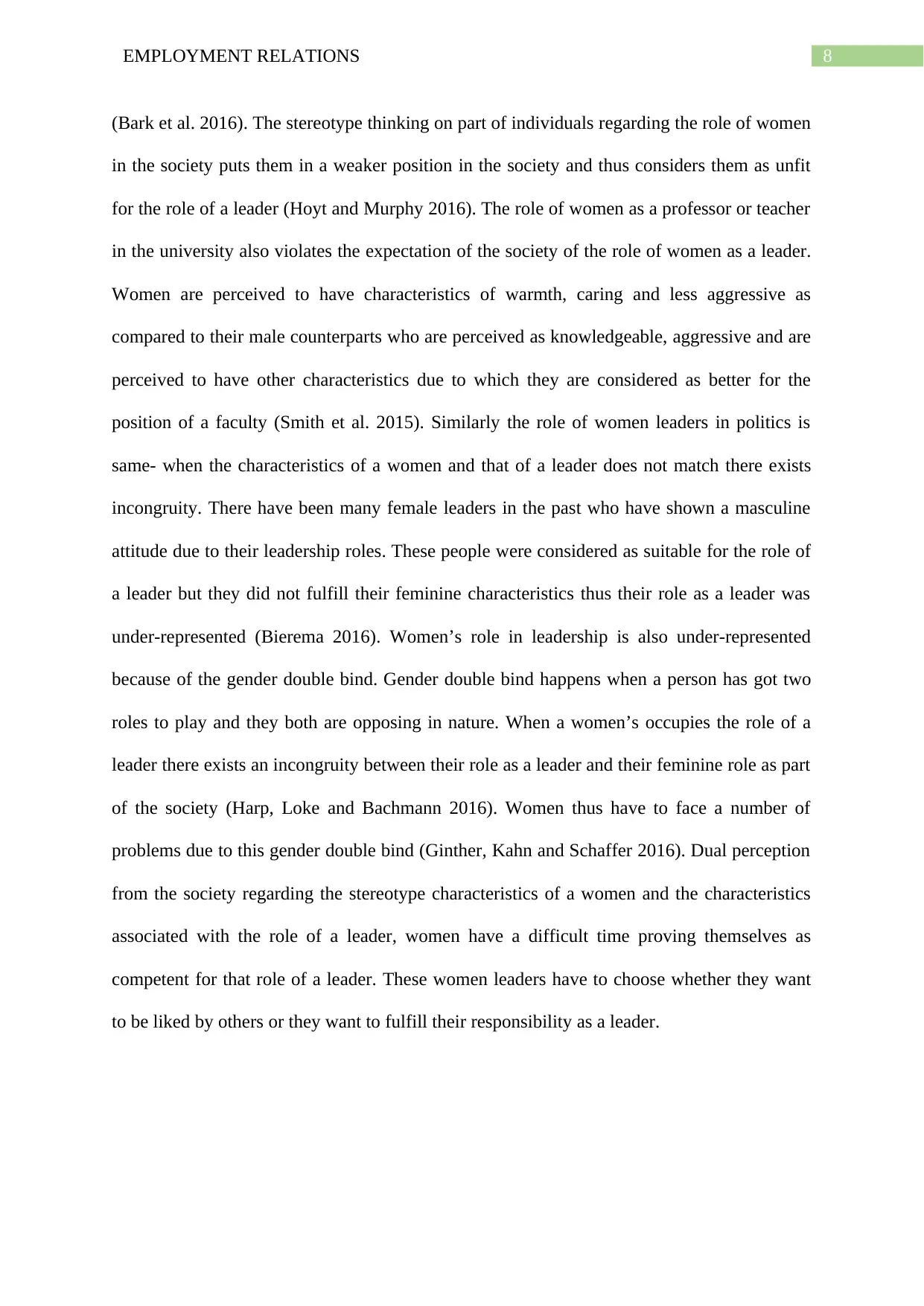
8EMPLOYMENT RELATIONS
(Bark et al. 2016). The stereotype thinking on part of individuals regarding the role of women
in the society puts them in a weaker position in the society and thus considers them as unfit
for the role of a leader (Hoyt and Murphy 2016). The role of women as a professor or teacher
in the university also violates the expectation of the society of the role of women as a leader.
Women are perceived to have characteristics of warmth, caring and less aggressive as
compared to their male counterparts who are perceived as knowledgeable, aggressive and are
perceived to have other characteristics due to which they are considered as better for the
position of a faculty (Smith et al. 2015). Similarly the role of women leaders in politics is
same- when the characteristics of a women and that of a leader does not match there exists
incongruity. There have been many female leaders in the past who have shown a masculine
attitude due to their leadership roles. These people were considered as suitable for the role of
a leader but they did not fulfill their feminine characteristics thus their role as a leader was
under-represented (Bierema 2016). Women’s role in leadership is also under-represented
because of the gender double bind. Gender double bind happens when a person has got two
roles to play and they both are opposing in nature. When a women’s occupies the role of a
leader there exists an incongruity between their role as a leader and their feminine role as part
of the society (Harp, Loke and Bachmann 2016). Women thus have to face a number of
problems due to this gender double bind (Ginther, Kahn and Schaffer 2016). Dual perception
from the society regarding the stereotype characteristics of a women and the characteristics
associated with the role of a leader, women have a difficult time proving themselves as
competent for that role of a leader. These women leaders have to choose whether they want
to be liked by others or they want to fulfill their responsibility as a leader.
(Bark et al. 2016). The stereotype thinking on part of individuals regarding the role of women
in the society puts them in a weaker position in the society and thus considers them as unfit
for the role of a leader (Hoyt and Murphy 2016). The role of women as a professor or teacher
in the university also violates the expectation of the society of the role of women as a leader.
Women are perceived to have characteristics of warmth, caring and less aggressive as
compared to their male counterparts who are perceived as knowledgeable, aggressive and are
perceived to have other characteristics due to which they are considered as better for the
position of a faculty (Smith et al. 2015). Similarly the role of women leaders in politics is
same- when the characteristics of a women and that of a leader does not match there exists
incongruity. There have been many female leaders in the past who have shown a masculine
attitude due to their leadership roles. These people were considered as suitable for the role of
a leader but they did not fulfill their feminine characteristics thus their role as a leader was
under-represented (Bierema 2016). Women’s role in leadership is also under-represented
because of the gender double bind. Gender double bind happens when a person has got two
roles to play and they both are opposing in nature. When a women’s occupies the role of a
leader there exists an incongruity between their role as a leader and their feminine role as part
of the society (Harp, Loke and Bachmann 2016). Women thus have to face a number of
problems due to this gender double bind (Ginther, Kahn and Schaffer 2016). Dual perception
from the society regarding the stereotype characteristics of a women and the characteristics
associated with the role of a leader, women have a difficult time proving themselves as
competent for that role of a leader. These women leaders have to choose whether they want
to be liked by others or they want to fulfill their responsibility as a leader.
⊘ This is a preview!⊘
Do you want full access?
Subscribe today to unlock all pages.

Trusted by 1+ million students worldwide
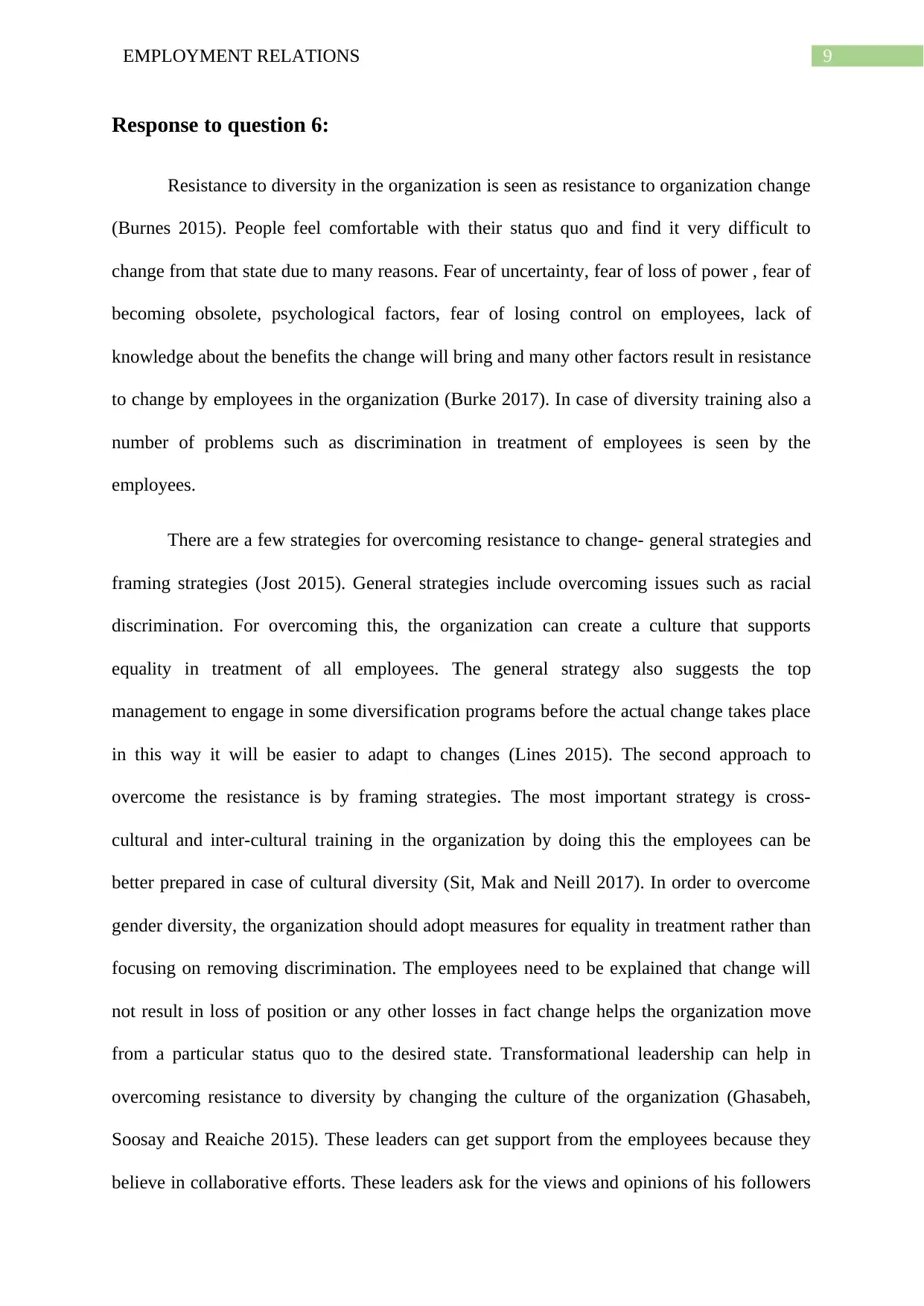
9EMPLOYMENT RELATIONS
Response to question 6:
Resistance to diversity in the organization is seen as resistance to organization change
(Burnes 2015). People feel comfortable with their status quo and find it very difficult to
change from that state due to many reasons. Fear of uncertainty, fear of loss of power , fear of
becoming obsolete, psychological factors, fear of losing control on employees, lack of
knowledge about the benefits the change will bring and many other factors result in resistance
to change by employees in the organization (Burke 2017). In case of diversity training also a
number of problems such as discrimination in treatment of employees is seen by the
employees.
There are a few strategies for overcoming resistance to change- general strategies and
framing strategies (Jost 2015). General strategies include overcoming issues such as racial
discrimination. For overcoming this, the organization can create a culture that supports
equality in treatment of all employees. The general strategy also suggests the top
management to engage in some diversification programs before the actual change takes place
in this way it will be easier to adapt to changes (Lines 2015). The second approach to
overcome the resistance is by framing strategies. The most important strategy is cross-
cultural and inter-cultural training in the organization by doing this the employees can be
better prepared in case of cultural diversity (Sit, Mak and Neill 2017). In order to overcome
gender diversity, the organization should adopt measures for equality in treatment rather than
focusing on removing discrimination. The employees need to be explained that change will
not result in loss of position or any other losses in fact change helps the organization move
from a particular status quo to the desired state. Transformational leadership can help in
overcoming resistance to diversity by changing the culture of the organization (Ghasabeh,
Soosay and Reaiche 2015). These leaders can get support from the employees because they
believe in collaborative efforts. These leaders ask for the views and opinions of his followers
Response to question 6:
Resistance to diversity in the organization is seen as resistance to organization change
(Burnes 2015). People feel comfortable with their status quo and find it very difficult to
change from that state due to many reasons. Fear of uncertainty, fear of loss of power , fear of
becoming obsolete, psychological factors, fear of losing control on employees, lack of
knowledge about the benefits the change will bring and many other factors result in resistance
to change by employees in the organization (Burke 2017). In case of diversity training also a
number of problems such as discrimination in treatment of employees is seen by the
employees.
There are a few strategies for overcoming resistance to change- general strategies and
framing strategies (Jost 2015). General strategies include overcoming issues such as racial
discrimination. For overcoming this, the organization can create a culture that supports
equality in treatment of all employees. The general strategy also suggests the top
management to engage in some diversification programs before the actual change takes place
in this way it will be easier to adapt to changes (Lines 2015). The second approach to
overcome the resistance is by framing strategies. The most important strategy is cross-
cultural and inter-cultural training in the organization by doing this the employees can be
better prepared in case of cultural diversity (Sit, Mak and Neill 2017). In order to overcome
gender diversity, the organization should adopt measures for equality in treatment rather than
focusing on removing discrimination. The employees need to be explained that change will
not result in loss of position or any other losses in fact change helps the organization move
from a particular status quo to the desired state. Transformational leadership can help in
overcoming resistance to diversity by changing the culture of the organization (Ghasabeh,
Soosay and Reaiche 2015). These leaders can get support from the employees because they
believe in collaborative efforts. These leaders ask for the views and opinions of his followers
Paraphrase This Document
Need a fresh take? Get an instant paraphrase of this document with our AI Paraphraser
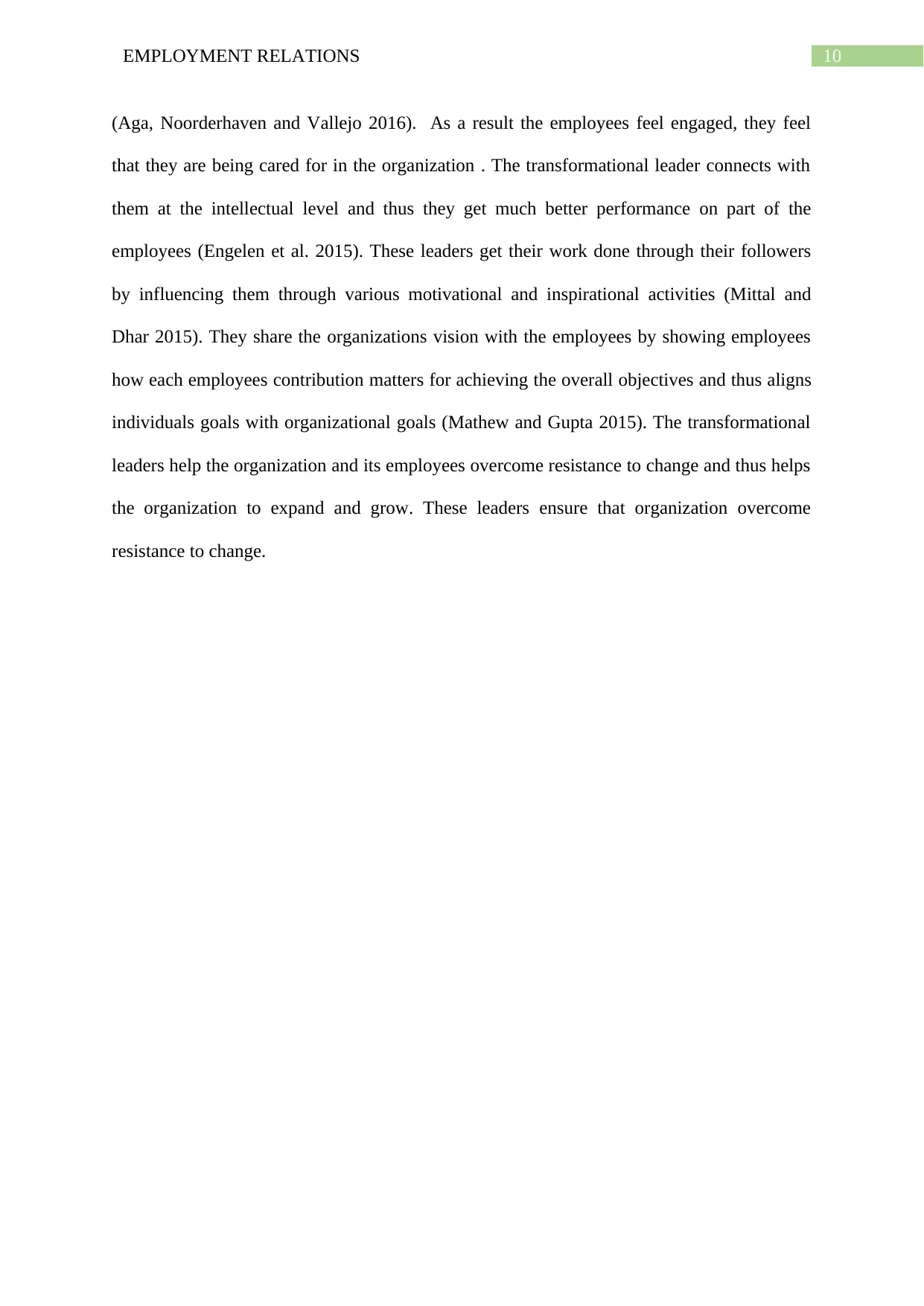
10EMPLOYMENT RELATIONS
(Aga, Noorderhaven and Vallejo 2016). As a result the employees feel engaged, they feel
that they are being cared for in the organization . The transformational leader connects with
them at the intellectual level and thus they get much better performance on part of the
employees (Engelen et al. 2015). These leaders get their work done through their followers
by influencing them through various motivational and inspirational activities (Mittal and
Dhar 2015). They share the organizations vision with the employees by showing employees
how each employees contribution matters for achieving the overall objectives and thus aligns
individuals goals with organizational goals (Mathew and Gupta 2015). The transformational
leaders help the organization and its employees overcome resistance to change and thus helps
the organization to expand and grow. These leaders ensure that organization overcome
resistance to change.
(Aga, Noorderhaven and Vallejo 2016). As a result the employees feel engaged, they feel
that they are being cared for in the organization . The transformational leader connects with
them at the intellectual level and thus they get much better performance on part of the
employees (Engelen et al. 2015). These leaders get their work done through their followers
by influencing them through various motivational and inspirational activities (Mittal and
Dhar 2015). They share the organizations vision with the employees by showing employees
how each employees contribution matters for achieving the overall objectives and thus aligns
individuals goals with organizational goals (Mathew and Gupta 2015). The transformational
leaders help the organization and its employees overcome resistance to change and thus helps
the organization to expand and grow. These leaders ensure that organization overcome
resistance to change.
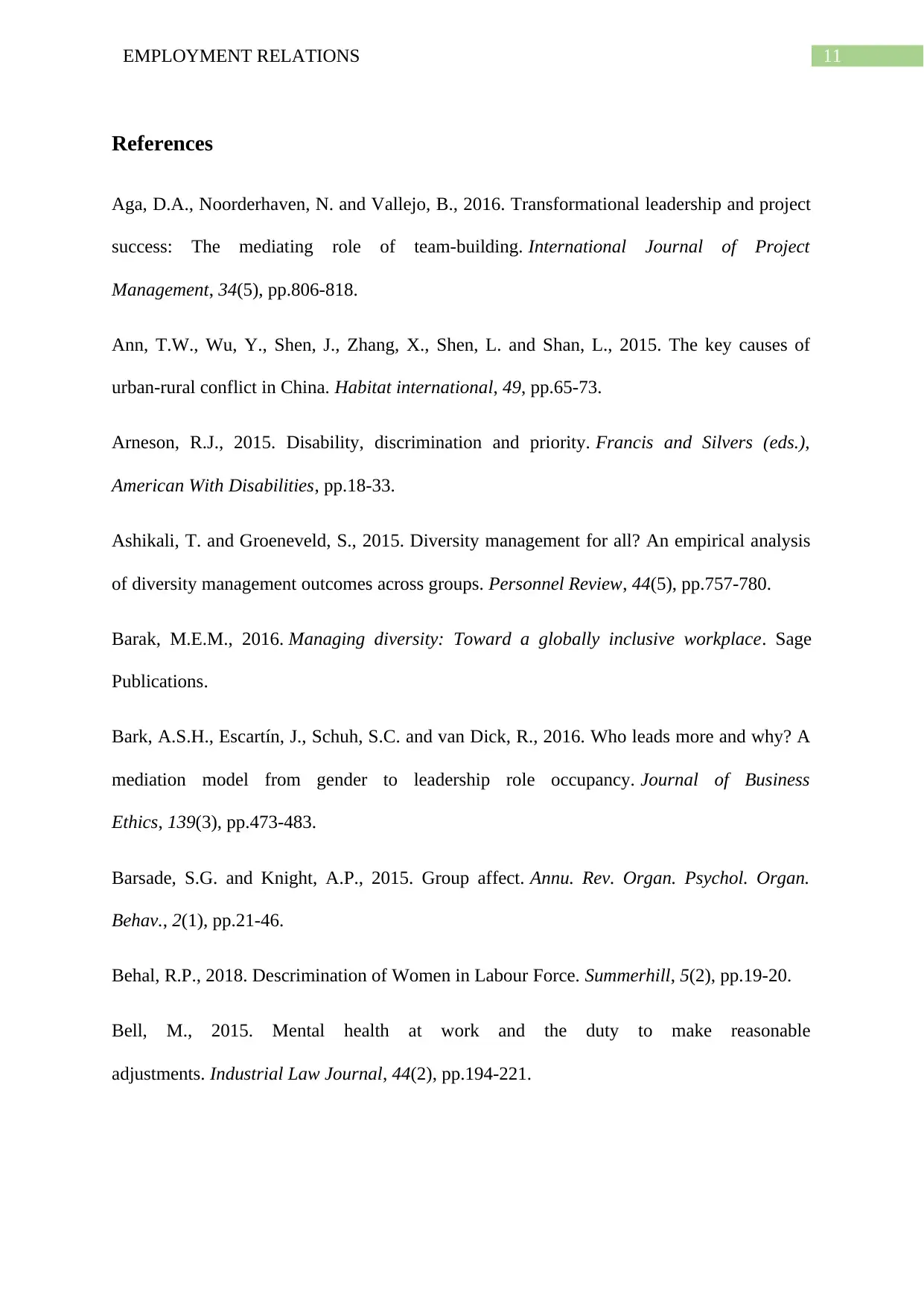
11EMPLOYMENT RELATIONS
References
Aga, D.A., Noorderhaven, N. and Vallejo, B., 2016. Transformational leadership and project
success: The mediating role of team-building. International Journal of Project
Management, 34(5), pp.806-818.
Ann, T.W., Wu, Y., Shen, J., Zhang, X., Shen, L. and Shan, L., 2015. The key causes of
urban-rural conflict in China. Habitat international, 49, pp.65-73.
Arneson, R.J., 2015. Disability, discrimination and priority. Francis and Silvers (eds.),
American With Disabilities, pp.18-33.
Ashikali, T. and Groeneveld, S., 2015. Diversity management for all? An empirical analysis
of diversity management outcomes across groups. Personnel Review, 44(5), pp.757-780.
Barak, M.E.M., 2016. Managing diversity: Toward a globally inclusive workplace. Sage
Publications.
Bark, A.S.H., Escartín, J., Schuh, S.C. and van Dick, R., 2016. Who leads more and why? A
mediation model from gender to leadership role occupancy. Journal of Business
Ethics, 139(3), pp.473-483.
Barsade, S.G. and Knight, A.P., 2015. Group affect. Annu. Rev. Organ. Psychol. Organ.
Behav., 2(1), pp.21-46.
Behal, R.P., 2018. Descrimination of Women in Labour Force. Summerhill, 5(2), pp.19-20.
Bell, M., 2015. Mental health at work and the duty to make reasonable
adjustments. Industrial Law Journal, 44(2), pp.194-221.
References
Aga, D.A., Noorderhaven, N. and Vallejo, B., 2016. Transformational leadership and project
success: The mediating role of team-building. International Journal of Project
Management, 34(5), pp.806-818.
Ann, T.W., Wu, Y., Shen, J., Zhang, X., Shen, L. and Shan, L., 2015. The key causes of
urban-rural conflict in China. Habitat international, 49, pp.65-73.
Arneson, R.J., 2015. Disability, discrimination and priority. Francis and Silvers (eds.),
American With Disabilities, pp.18-33.
Ashikali, T. and Groeneveld, S., 2015. Diversity management for all? An empirical analysis
of diversity management outcomes across groups. Personnel Review, 44(5), pp.757-780.
Barak, M.E.M., 2016. Managing diversity: Toward a globally inclusive workplace. Sage
Publications.
Bark, A.S.H., Escartín, J., Schuh, S.C. and van Dick, R., 2016. Who leads more and why? A
mediation model from gender to leadership role occupancy. Journal of Business
Ethics, 139(3), pp.473-483.
Barsade, S.G. and Knight, A.P., 2015. Group affect. Annu. Rev. Organ. Psychol. Organ.
Behav., 2(1), pp.21-46.
Behal, R.P., 2018. Descrimination of Women in Labour Force. Summerhill, 5(2), pp.19-20.
Bell, M., 2015. Mental health at work and the duty to make reasonable
adjustments. Industrial Law Journal, 44(2), pp.194-221.
⊘ This is a preview!⊘
Do you want full access?
Subscribe today to unlock all pages.

Trusted by 1+ million students worldwide
1 out of 18
Related Documents
Your All-in-One AI-Powered Toolkit for Academic Success.
+13062052269
info@desklib.com
Available 24*7 on WhatsApp / Email
![[object Object]](/_next/static/media/star-bottom.7253800d.svg)
Unlock your academic potential
Copyright © 2020–2025 A2Z Services. All Rights Reserved. Developed and managed by ZUCOL.





